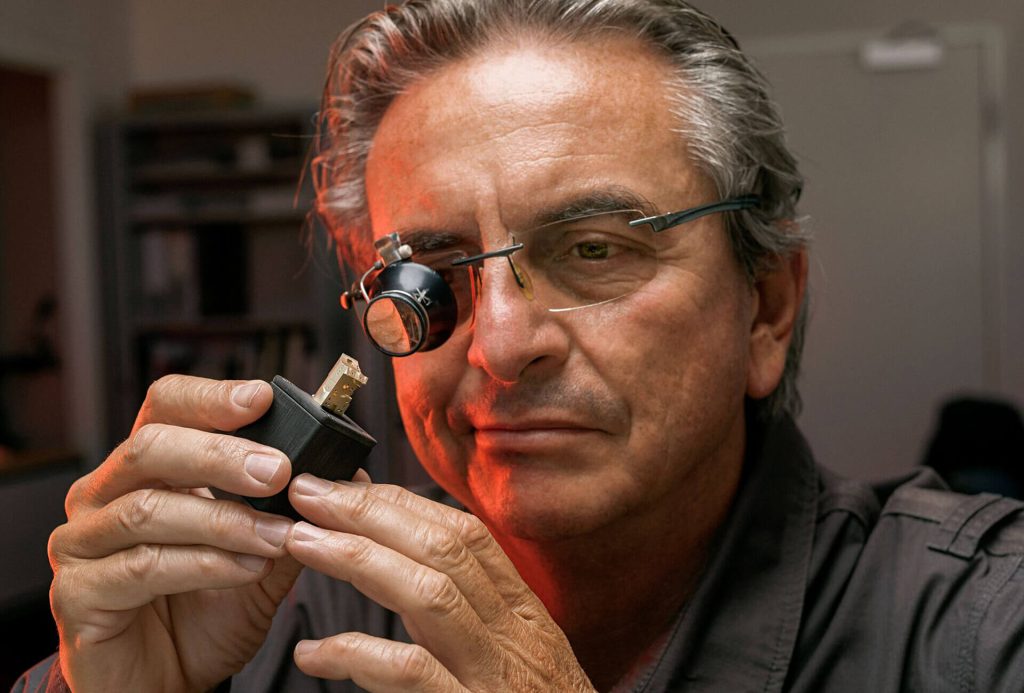The History Of Rolex Daytona

The History Of Rolex Daytona
When I first said the word “Daytona,” you might think of a watch with two pushers on the side, three subdials on the dial, and a crown at the 12 o’clock position with the word “Rolex” printed below. However, before the Rolex Daytona swept over the watch market, “Daytona” referred to a racetrack located in Florida. How did all of this change so suddenly? To understand the situation, we will go back to the past to explore the history of the Rolex Daytona.
Rolex In The Racing World
Rolex is intimately associated with racing. When you watch a Formula 1 race, you’ll quickly notice the tracks adorned with Rolex logos. You just can’t unsee it. But how did Rolex enter the world of racing in the first place? To find out, we must go back to the 1930s.
Many famous race car drivers have been closely associated with Rolex throughout history, including Steve McQueen, Paul Newman, and Richard Petty. These are men of achievement who always pushed the envelope. However, there was another individual with remarkable accomplishments who broke more land and water speed records than anyone else in history, popularizing auto racing and bringing Rolex into the racing world. His name was Sir Malcolm Campbell.
(Photo from Wikipedia)
Sir Malcolm Campbell was not an ordinary man or an ordinary race car driver. In fact, he broke the world land speed record nine times between 1924 and 1936 with his famous Blue Bird race cars. Although Sir Malcolm Campbell was British, he often traveled to Daytona Beach, Florida, where he continued to set one world speed record after another. It seems a little strange today, but back then, he set these records driving on the actual beach, on the sand, as pictured below.
(Photo from Petrolicious)
With the successful development of the world’s first dive watch in 1926, the Rolex Oyster, it was worn by Mercedes Gleitze around her neck when she swam the English Channel from France to England. She is also known as the first Englishwoman to swim the English Channel (Mercedes did not complete the swim and was pulled out of the water seven miles from England, but Hans Wilsdorf ignored the fact that she did not finish and used her celebrity endorsement to advertise the Rolex Oyster). Soon after this event, Rolex became known for its reliability and durability, with the slogan “Sealed against the elements,” which was embraced by many celebrities. One of them was Sir Malcolm Campbell.
As we can see from the 1930s Rolex Oyster advertisement pictured below, not only did Sir Malcolm Campbell wear a Rolex, but he also refused to allow Rolex to pay him to wear it.
(Photo from WatchinTyme)
(Photo from Berne Horology)
The owner of Rolex, Hans Wilsdorf, was extremely impressed with Sir Malcolm Campbell’s achievements and lifestyle, believing he symbolized the Rolex ethos. As a result, Campbell became Rolex’s first true ambassador. While Mercedes Gleitze was Rolex’s first ambassador, she represented the brand for only one event. In contrast, Sir Malcolm Campbell’s ambassadorship lasted for many years, and Rolex even released a Sir Malcolm Campbell model, as shown in the picture below.
(Photo from Waddingtons)
In 1935, Sir Malcolm Campbell attempted to break the 300 MPH barrier as we see from the program below with him on the cover from Daytona Beach,Florida.
(Photo from StockX)On March 7, 1935, Sir Malcolm Campbell continued to break one world speed record after another when he hit 276.82 MPH (442.91 KPH). Before achieving this new record, he encountered complications and had to wait five weeks for the Daytona Beach sand to become smooth enough to drive on. He broke his previous record by only 4 MPH. Unfortunately, he was not able to achieve his goal of reaching 300 MPH.
(Photo from RolexMagazine)
To achieve his goal of 300 MPH, Sir Malcolm Campbell decided to move to the Bonneville Salt Flats in late 1935, as the track at Daytona Beach had become too worn and developed many holes. The Bonneville Salt Flats offered a better option, with its 159 square miles of flat salt surface located in northwestern Utah.
(Photo from Wikipedia)
The decision was made because Sir Malcolm Campbell realized that to reach 300 MPH, it would take him several miles to accelerate to maximum speed. Once he achieved that speed, it would also take him many miles to slow down. Furthermore, the brakes were not very effective in the 1930s, so he had to decelerate gradually by slightly easing off the gas pedal; hitting the brakes at 300 MPH would have caused the car to burn up instantly.
On September 3, 1935, Sir Malcolm Campbell successfully achieved his goal, reaching a maximum speed of 301.13 MPH, as shown below.
(Photo from RolexMagazine)
After Sir Malcolm Campbell moved to the Bonneville Salt Flats, Daytona Beach lost its major showcase opportunity. The officials in the city decided to maintain Daytona Beach as the winter hub and epicenter of American racing.
In 1936, the world’s first stock car race was held on Daytona Beach. The race consisted of 78 laps and covered a distance of 400 km. Two years later, William France took over the management of Daytona Beach, accepting the role of course manager while also competing in the event. From 1938 to 1941, William France continued to race and manage Daytona Beach.
William France is featured in the Rolex Zephyr advertisement from 1960, as shown in the picture below:
(Photo from RolexMagazine)
Rolex Daytona Was Almost Named Rolex Le Mans Chronograph!!!
In 1953, Rolex registered the name “Cosmograph,” which was first placed on the Rolex Moonphase watch, ref. 6062. Rolex originally used the term “Chronograph” for their chronograph watches, but around the late 1960s, they decided to change the name from Rolex Chronograph to Rolex Cosmograph.
Some sources speculate that in 1962, Rolex first used the “Daytona” designation on a watch to capitalize on the rapidly increasing popularity of NASCAR racing, which featured souped-up stock cars that resembled Hot Rods or Muscle Cars.
However, in 1964, Rolex chose to associate its chronograph watches with a world-class race—in particular, the Le Mans race in France. Yes, you heard it right: the Rolex Daytona that everybody knows and loves was almost named the Rolex Le Mans!
Here’s the extremely rare ad for the Rolex Le Mans Chronograph from 1964:
(Photo from RolexMagazine)
This ad appeared in the Sebring Race Program from 1964 on page 56. The Sebring International Raceway is a road course auto racing facility located in Sebring, Florida. It is well known for hosting the 12 Hours of Sebring. The track is 6 km long and features 17 turns, including long straightaways and challenging corners. It has been in operation since 1950 and has hosted a variety of different types of races, including sports car racing, motorcycle racing, and open-wheel racing.
On the other hand, Le Mans is the oldest endurance race in France, dating back to 1923, with interruptions only for wars and general strikes. The track is 13.6 km long. In 1955, it featured a number of interesting attributes, including one of the longest straight sections of any motor racing track available at the time. A 6 km long straight allowed drivers to achieve incredible speeds, making for particularly exciting races. It was the world’s most prestigious endurance race, with cars competing in repeated laps of the circuit over the course of 24 hours. The top prize went to the team that traveled the farthest distance within the time limit.
However, in late 1964, Rolex reintroduced the Rolex Daytona Chronograph, as pictured below.
(Official 1965 Rolex Advertising)
So, what’s the reason why Rolex changed the name back to “Rolex Daytona” instead of continuing to use the name “Rolex Le Mans”? It is difficult to confirm for certain, but here’s my theory.
My first guess is that Rolex has long been associated with Daytona, which is also how they entered the racing world in the first place. Their strong affiliation with the Speed King, Sir Malcolm Campbell, who broke numerous world speed records on Daytona Beach, supports this. Therefore, it’s no surprise that Rolex used the name “Daytona” instead of “Le Mans.”
Alternatively, I believe they may have planned to call it the “Daytona Chronograph” instead of the “Le Mans Chronograph” simply because “Daytona” sounds better.
It also occurs to me that perhaps the name “Le Mans” is considered unlucky due to the Le Mans disaster in 1955, the most deadly motor racing crash of all time, which resulted in hundreds of traumatic injuries and the deaths of Pierre Levegh and 79 others.
Below is a newspaper from 1955 about the Le Mans disaster:
(Photo from Timothy Hughes Rare Newspapers)
But for the “Le Mans” Rolex perhaps one day we will have a concrete answer to this question.This wouldn’t be the first or the last time Rolex has tried out a name and then changed it significantly. In 1955, they briefly named the Rolex “Submariner” the “Skin Diver.” At one point in the mid-1950s, Rolex also referred to the Submariner as the “Sub-Aqua.”
Daytona Beach in the 1950s:
(Photo from Wikipedia)
Daytona track in the late 1960s:
(Photo from Luftgekuhlt)
Daytona race track in the 1980s:
(Photo from Ferrari)
Daytona race in 2021:
(Photo from USA Today Sports)
Paul Newman
“The King of Cool,” aka Paul Newman, was a man who was intrinsically linked to the Rolex Daytona. If Paul Newman hadn’t worn the Rolex Daytona in 1972, I am sure it wouldn’t have gained the prominence it has today.
The California Governor, Arnold Schwarzenegger, once said: “Paul Newman was the ultimate cool guy whom men wanted to be like and whom women adored. He was an American icon, a brilliant actor, a Renaissance man, and a generous but modest philanthropist. He entertained millions in some of Hollywood’s most memorable roles and brightened the lives of many more, especially seriously ill children, through his charitable works. Paul was one of a kind. The beloved film star will be missed by a world of fans and admirers.”
Paul Newman’s first Rolex Daytona was given to him by his wife, Joanne Woodward, in 1972, the same year he started his professional racing career, as pictured below.
(Photo from RolexMagazine)
The term “The Paul Newman Daytona” is somewhat of an oxymoron. In fact, it refers to a Daytona with the exotic dial. The reason it is called “the exotic dial” is that it has a black outer track running around the edge of the dial that matches the subdials. Paul Newman was a huge fan; he owned and wore at least five different Rolex Daytonas in his lifetime.
So, where did the term “The Paul Newman Daytona” come from? Some might say it originated from overzealous auction houses and vintage Rolex dealers who wanted to charge a premium price for selling the Rolex Daytona. However, as we look at the advertisement by Rolex shown below, Paul Newman was wearing an exotic dial stainless steel Rolex Daytona on a fat strap. The Rolex he was wearing in the advertisement might be Reference 6241 or 6239, and it is perhaps this image that created the phrase “The Paul Newman Daytona.”
(Rolex Advertisement)
Rolex is renowned for its strategic marketing skills, so the obvious question is whether or not Rolex was so adroit that they were able to create this amazing mystique by associating the Rolex Daytona with Paul Newman. In an interview between Rolex historian John Brooke and Paul Newman, Newman stated that he never had any association with Rolex.
Therefore, if Rolex created this connection quietly, it would have made them brilliant marketing geniuses. The other possibility is that it just happened, and later on, auction houses grabbed the ball and ran with it.
It is fascinating to realize that Paul Newman was deeply inspired by the Rolex Daytona watches, and Rolex was equally inspired by Paul Newman as well; it ended up being a perfectly symbiotic relationship.
A Rolex advertisement featuring Paul Newman from the movie “Winning”.
(Photo from Daytona Info)
Paul Newman was also known for his devotion to his wife Joanne Woodard and his three girls.
(Photo from Things Of The Past)
The photo below is from People Magazine and it was taken in 1963. Racing car legend, Mario Andretti, who was close friend with Paul Newman said “It was so evident that they were madly in love with other forever”
(Photo from The Mind Will Follow)
However, before Paul Newman met and fell in love with Joanne Woodward, he was married to his first wife, Jackie Witte. They were married in 1949 and divorced in 1958, having had a son and two daughters. Paul Newman and Joanne Woodward were married on February 2, 1958, and they had three daughters.
In an autobiography written many years later, Paul Newman revealed that when he divorced his first wife, he “felt guilty as hell.”
(Photo from MutualArt)
Paul Newman’s acting career spanned six decades. He began his acting journey by attending The Actor’s Studio in New York City.
The photo above was taken in 1955, the same year James Dean attended The Actor’s Studio. Notice that all the men in the photo are wearing suits with ties, while Paul Newman is the only one wearing a T-shirt with white socks and moccasins.
*Butch Cassidy and the Sundance Kid* is considered to be one of Paul Newman’s greatest movies, released in 1969. Robert Redford co-starred with Newman in the film. It is ironic because Steve McQueen was originally chosen to star in the movie opposite Paul Newman, but their lawyers could not agree on which star would get top billing.
It’s also interesting to mention that the leader of North Korea, Kim Jong-il, was a big fan of Hollywood; he even started making films himself, inspired by Hollywood. It’s likely that Kim Jong-il also watched Paul Newman’s movies.
(Photo from 20th Century Studios)
The next two photos of Paul Newman were taken just before he passed away in 2008. Of course he was at the race track with his Daytona, Paul Newman had pure passion for Rolex and Racing.
(Photo from Independent)
By the time Paul Newman was 83 years old, I was only 4 years old. Whenever I look at the photos it makes me sad and pity. He was still alive when I was born. A legend that only appeared in movies was close yet far away to me. Rest in peace Paul Newman.
Zenith And Rolex
During the years from 1988 to 2000, Rolex Daytona watches were outfitted with a reliable movement from Zenith.
The story began in 1988 at Baselworld, where Rolex introduced their first self-winding chronograph and the most significant redesign of their sports watch, the automatic Daytona. The 16520 Daytona heralded the introduction of a new 40mm case and a sapphire crystal.
The first self-winding chronograph from Rolex is the Zenith-powered 165xx. The 165xx series watches have almost doubled in value over the past two or three years.
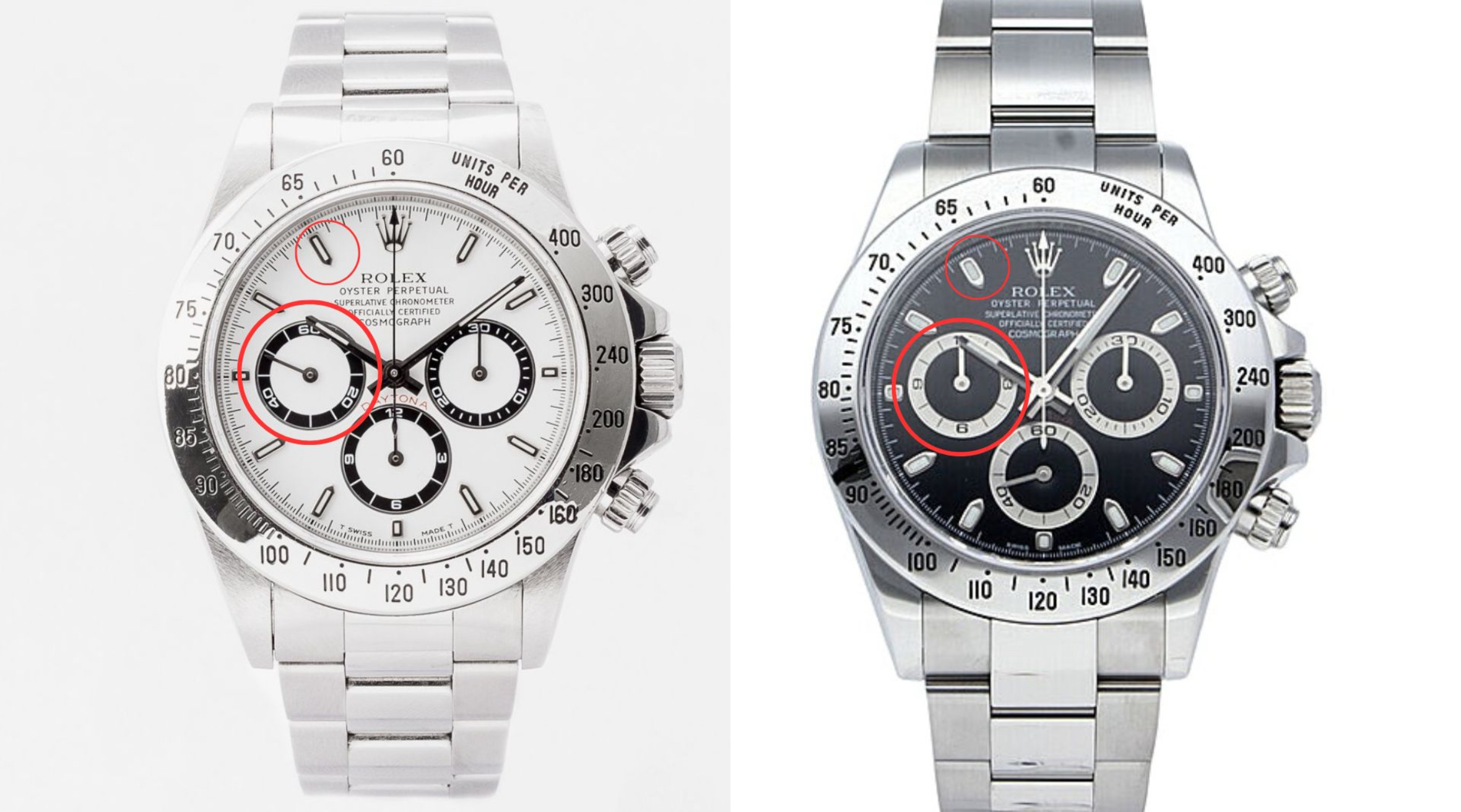
The Zenith Daytona (left) & The Rolex Daytona (right)
The difference between the Rolex movement and the Zenith movement is that the second hand subdial on the Zenith movement version is located at the 9:00 position, while it is at the 6:00 position on the Rolex movement version, as pictured above.
Brief Introduction to Every Rolex Daytona Models
Rolex Daytona Reference 6238
Rolex 6238 is considered the precursor of the Rolex Daytona that why people also call it “Pre-Daytona”
Produced from 1962 to 1968 in stainless steel,14 kt and 18 kt gold, the last model had a smooth bezel and the tachometer scale printed on the dial.
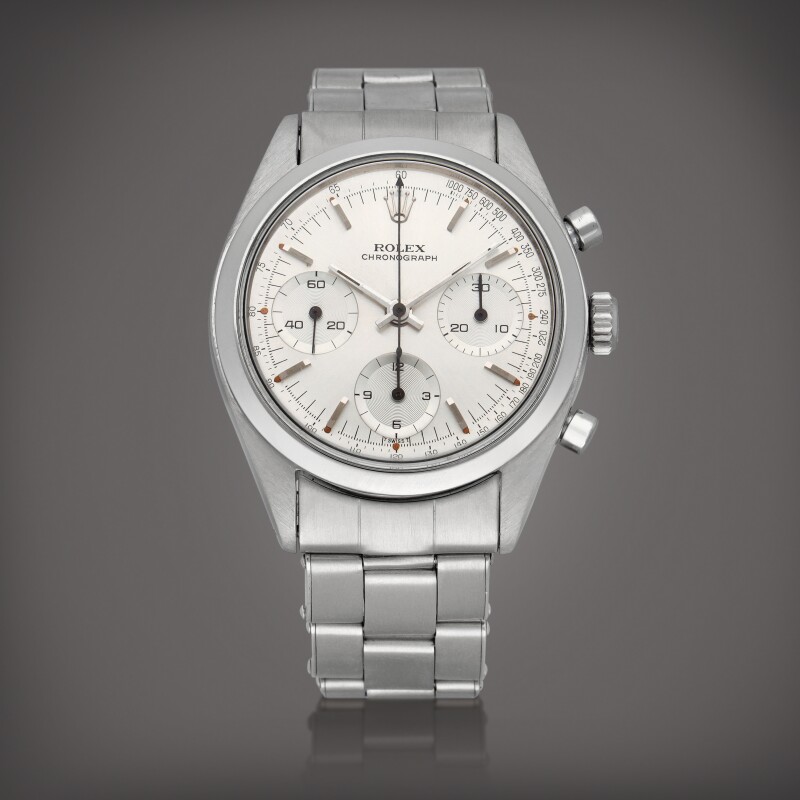
(Photo from Sotheby)
Rolex Daytona Reference 6239
First released in 1963, the Rolex Cosmograph 6239 initial model became the Rolex Cosmograph Daytona. The name “Daytona” was added to the dial about a year after the release. This watch features the classic tachometer scale engraved on the metal bezel unlike the 6238 painted on the dial instead.
In 2017,the renowned Paul Newman’s own Rolex Daytona ref.6239 with exotic dial sold for a record-breaking $17.8 million.
Rolex Daytona 6240
This model is the first Daytona featuring an Oyster case fitted with screw-down pushers and crown for better water resistancy. The 6240 was produced as a prototype, thus there’s only a small quantity of them.
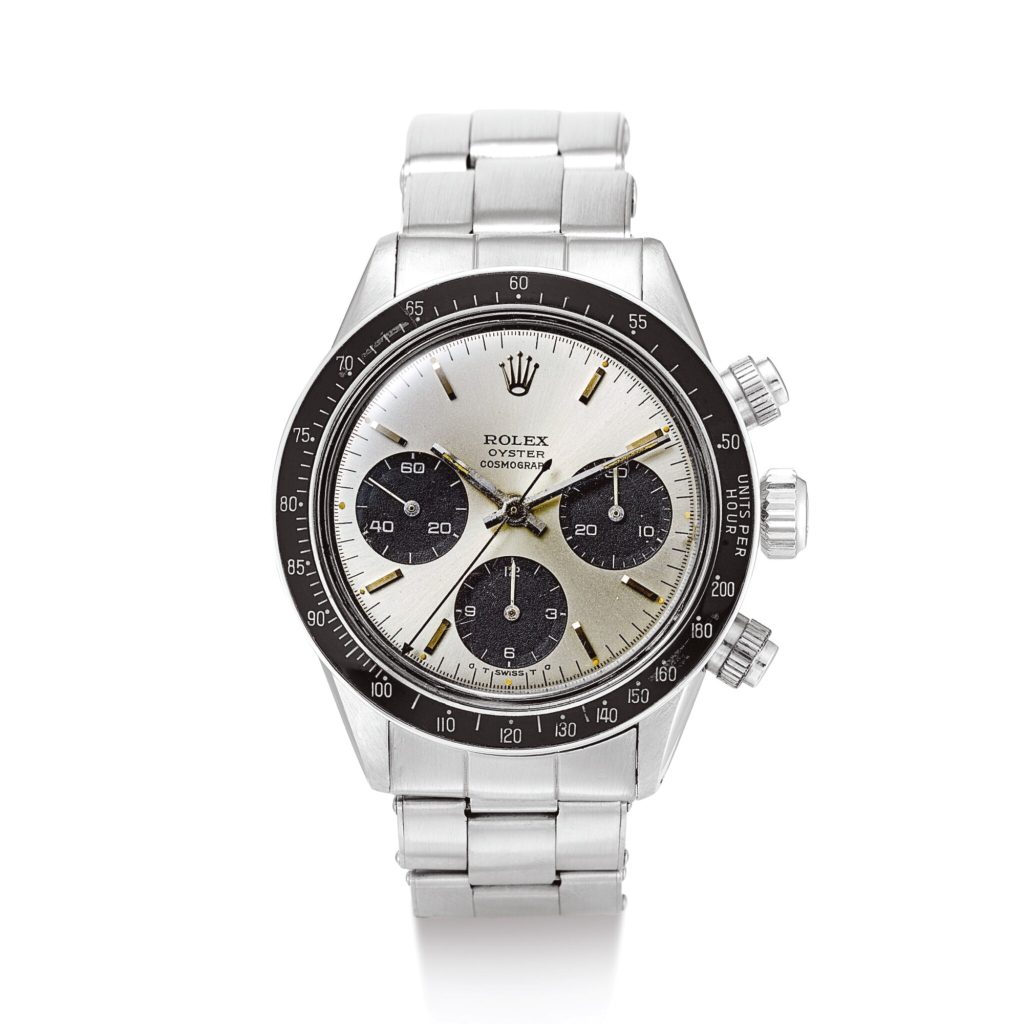
(Photo from Sothby)
Rolex Daytona Reference 6262
The Rolex 6262 is the most limited watches in Rolex collection in view of the fact that they produced this model for 1 year only from 1970 to 1971.
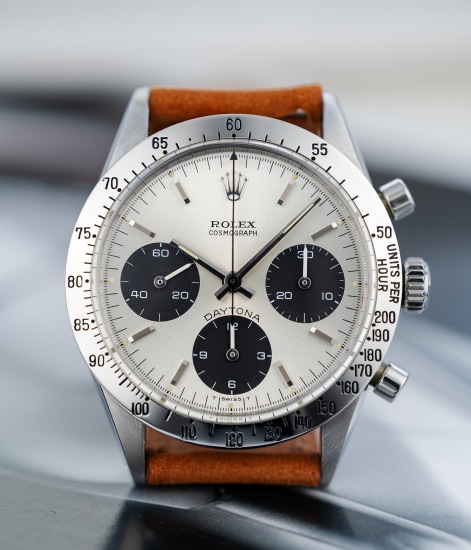
(Photo from Phillips)
Rolex Daytona Reference 6263
The Rolex 6263 also features an Oyster case with screw-down pushers and crown. Some early versions of the 6263 only included the word “Cosmograph” but not “Daytona” as pictured below.
(Photo from Sotheby)
Rolex Daytona 6264
The Rolex 6264 only produced in few numbers between 1969 to 1972. The 6264 featured a new caliber Valjoux 727, replacing the previous lower beat Daytona.
(Photo from Phillips)
Rolex Daytona Reference 6269
The Rolex 6269 is one of the most special watches in the Rolex Collection.The watch is not only made from 18kt yellow gold, but also completed with diamonds in the bezel and dial. It’s also an Oyster watch. These watches are seriously rare.
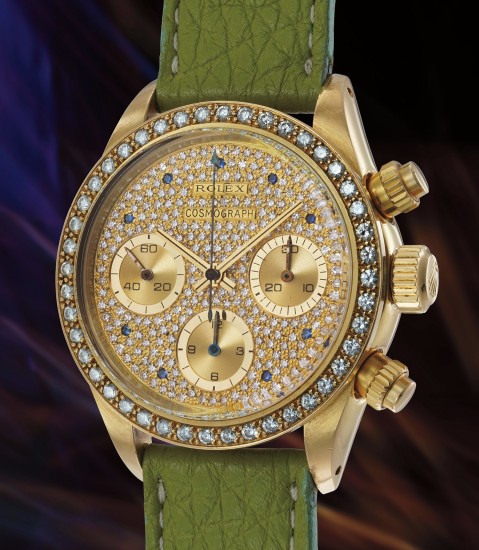
(Photo from Phillips)
Rolex Daytona Reference 6270
There only eight Rolex 6270 were made especially for his majesty Qaboos Bin Said of Oman.The 6270 is a full yellow gold watch with a pave diamond set dial, baguette diamond bezel.
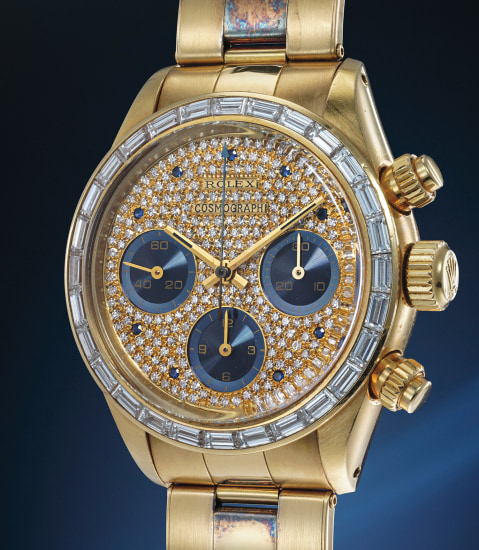
Rolex Daytona Reference 16520
The Rolex 16520 is Rolex’s first automatic Daytona. The watch is also nicknamed the “Zenith Daytona” as the movement is Zenith powered 165xx, a modified Zenith El-Primero based caliber.
(Photo from Watchfinder)
Rolex Daytona Reference 116520
The Rolex 116520 was released in 2000. Fitted with an in-house Rolex caliber. It was discontinued in 2016
(Photo from Watchfinder)
Rolex Daytona Reference 116528
The Rolex 116528 is the same concept as the in-house Rolex but made in full yellow gold; some versions of the 116528 feature a red hand. It was produced from 2000 to 2016.
(Photo from Sotheby)
Rolex Daytona Reference 116500
The Rolex 116500 was the first stainless steel Daytona to feature a ceramic bezel. This model was released in 2016 and still a relatively new model.
(Rolex Official)
Rolex Daytona Reference 126506
On the 60th anniversary of the Rolex Daytona, Rolex released the new model of the Daytona, the 126xx series. The movement of the Daytona was replaced by the new caliber 4131, which features a more efficient Chronergy escapement and additional ball bearings in the rotor. The Daytona remains 40mm and has a 72-hour power reserve. What’s more interesting is that, for the first time in history, Rolex has included a sapphire case back in their watches. This allows us to look more closely at the Rolex movement. They also added Côtes de Genève finishing to the bridges.
The ceramic bezel is another significant change to the look; the bezel is now surrounded by the same metal as the case itself. You might wonder, “Isn’t it less durable and easier to stretch the bezel?” To answer this, the ceramic doesn’t stretch to the edge of the bezel itself—it’s a practical measure. Unless you happen to knock the bezel edge pretty hard and shatter the whole thing, everything should be alright.
The hour markers are also smaller, which makes the dial look more like the old Zenith Daytona.
(Rolex Official)
The Reborn of “Le Mans”
In 2023, Rolex announced stunning news with the introduction of the new Rolex Le Mans 126529LN to mark the 100th anniversary of the Le Mans circuit. This sent shockwaves through the watch world, and Rolex made its appearance only after Watches and Wonders had wrapped up. The watch shares some similarities with the legendary “Paul Newman” Daytona Ref. 6263. It features silver subdials with “lollipop” markers and displays a red “100” on the watch’s black tachymeter scale below 7 o’clock to commemorate the 100th anniversary of Le Mans.
Rolex also updated the Daytona caliber 4131 for this release, featuring the Paraflex shock protection system and the Chronergy escapement, which shields the caliber from strong magnetic fields. Additionally, it has a sapphire case back to showcase the movement.
(Rolex Official)
However, the Rolex “Le Mans” 126529LN was short-lived and was soon replaced by the “Le Mans” 126528LN, which features a yellow gold version. Unlike the white gold version, this one wasn’t listed on the website, making it an off-catalog release.
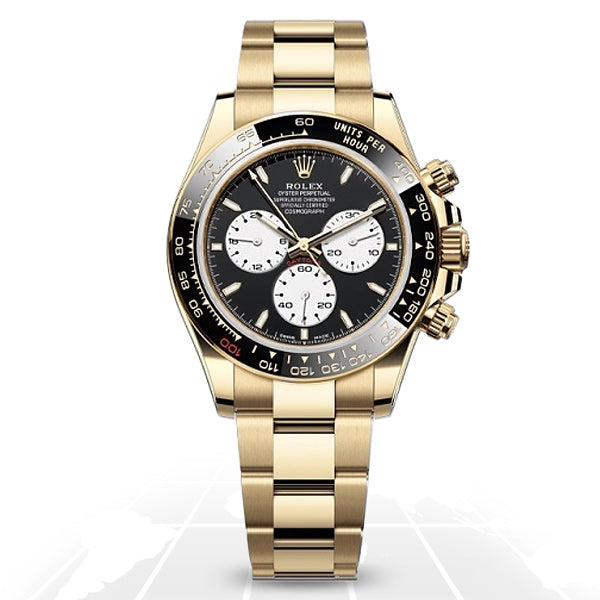
(Rolex Official)
Overall, it was indeed a surprise gift from Rolex, although the Rolex watch models still haven’t changed significantly. I can see Rolex starting to value and emphasize their history more. This brings me joy, and I am looking forward to what Rolex will bring in the future!
By Kory

